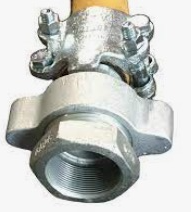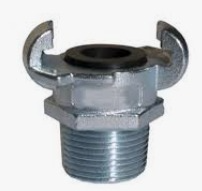In industrial settings, the reliable transfer of fluids is a lifeline. Whether it’s powering pneumatic tools, supplying air to compressors, or transporting water for cooling, bull hose fittings are the unsung heroes that maintain the fluid connections upon which countless industries rely.
What is a Bull Hose Fitting?
WIRE Braided Bull Hose (Male x Female Threaded) MultiBlast Bull Hose Male Claw Fitting
Bull hose fittings stand as essential components for the conveyance of air, water, fuel, and various fluids. These unassuming connectors play a vital role in ensuring that materials flow efficiently and reliably through hoses. Let’s delve into the world of bull hose fittings, exploring their types, materials, sizes, and applications.
Types of Bull Hose Fittings
A. Male End Fittings
Male bull hose fittings have external threads that enable them to connect to female fittings. These versatile fittings can come in various configurations to meet different requirements.
B. Female End Fittings
Female bull hose fittings feature internal threads to receive male fittings. They are available in a wide range of sizes and thread types.
C. Combination Nipples
Combination nipples are dual-ended fittings that offer flexibility in hose connection. They can have a combination of male and female ends or different sizes on each side.
D. Swivel Fittings
Swivel bull hose fittings can rotate, providing a greater range of motion and reducing strain on hoses. They are commonly used in applications where hoses need to move freely.
E. Nuts and Ferrules
Nuts and ferrules are used to secure hoses to fittings. They stop leaks and form a tight seal.
Materials and Durability
A. Stainless Steel Bull Hose Fittings
Fittings made of stainless steel are incredibly strong and resistant to corrosion. They are ideal for applications where the fittings may come into contact with corrosive materials.
B. Brass Bull Hose Fittings
Brass fittings are known for their excellent machinability and durability. They are commonly used for water and air applications.
C. Aluminum Bull Hose Fittings
Aluminum fittings are lightweight and offer good corrosion resistance. They are ideal for various industrial applications.
D. Composite Materials
Composite materials are chosen for their unique properties, such as high strength and resistance to chemical exposure.
E. Corrosion Resistance
Corrosion resistance is a critical factor in selecting materials for bull hose fittings. Different industries require materials that can withstand specific environmental challenges.
Thread Types in Bull Hose Fittings
A. NPT (National Pipe Tapered)
NPT threads are common in bull hose fittings and provide a tight seal. Understanding the NPT thread system is essential for proper installation.
B. BSPT (British Standard Pipe Taper)
BSPT threads are used in some applications, and recognizing the differences between NPT and BSPT is crucial.
C. NPSM (National Pipe Straight Mechanical)
NPSM threads offer a straight connection, and knowing when to use them is key to successful installations.
D. JIC (Joint Industry Council)
JIC threads are prevalent in hydraulic systems and understanding their characteristics ensures the reliability of connections.
E. O-Ring Face Seal
O-ring face seal fittings create a tight connection with an elastomeric seal and are prevalent in hydraulic and pneumatic systems.
Installation and Maintenance
A. Proper Installation Procedures
Following the correct installation procedures ensures the longevity and effectiveness of bull hose fittings.
B. Periodic Inspection
Routine inspections can identify wear, leaks, or potential issues before they become critical problems.
C. Maintenance Tips
Implementing maintenance strategies can extend the lifespan of bull hose fittings and save both time and money.
Applications of Bull Hose Fittings
A. Air Compressors
In air compressor systems, bull hose fittings facilitate the flow of compressed air to power various tools and machinery.
B. Water Transfer
Bull hose fittings are used to transfer water for cooling and irrigation, playing a crucial role in maintaining processes and landscapes.
C. Fuel and Oil Handling
In fuel and oil handling systems, these fittings are essential to prevent leaks and ensure the safe transfer of flammable materials.
D. Pneumatic Tools
For pneumatic tools to function efficiently, they rely on the secure connections provided by bull hose fittings.
E. Hydraulic Systems
Bull hose fittings are integral in hydraulic systems, supporting the flow of hydraulic fluid in heavy machinery, vehicles, and industrial equipment.
Safety Considerations
A. Pressure Ratings
Understanding the pressure ratings of bull hose fittings is paramount to maintaining safety in high-pressure applications.
B. Temperature Limits
Bull hose fittings must withstand extreme temperatures in some applications, and knowing their limits is crucial.
C. Proper Handling
Safe handling practices for bull hose fittings prevent accidents and injuries during installation and maintenance.
D. Avoiding Common Mistakes
Identifying and avoiding common mistakes, such as over tightening fittings, ensures the reliability of connections.
Where to Source Bull Hose Fittings
A. Local Suppliers
Local suppliers may offer convenience and the advantage of inspecting fittings in person.
B. Online Retailers
Online retailers provide access to a vast selection of bull hose fittings, often with convenient shipping options.
C. Specialized Hose and Fitting Stores
Specialized hose and fitting stores can offer expert guidance and tailored solutions for specific needs.
D. Custom Fitting Services
Custom fitting services are available for industries with unique requirements or non-standard configurations.
Customization and Specialized Fittings
A. Tailored Solutions
Customized bull hose fittings cater to specific needs, such as unique size requirements or compatibility with specialized equipment.
B. Niche Industrial Needs
Certain industries demand specialized fittings, and manufacturers can create customized solutions to meet these niche requirements.
C. Unique Configurations
Some applications require unique configurations or adaptations, and customization allows for precise fittings.
Advantages of Bull Hose Fittings
A. Versatility
Bull hose fittings are versatile and can adapt to various applications and environments.
B. Secure Connections
Properly installed bull hose fittings create secure and leak-free connections.
C. Durability
The materials used in bull hose fittings are chosen for their durability and ability to withstand challenging conditions.
D. Reduced Downtime
Reliable connections lead to less downtime and increased productivity in industrial operations.
E. Cost-Effective
Investing in quality bull hose fittings is cost-effective in the long run, reducing maintenance and replacement expenses.
Industry Standards and Certifications
A. ISO Standards
ISO standards ensure uniformity and quality in bull hose fittings across industries.
B. Quality Assurance
Quality assurance practices are crucial to meeting industry standards and satisfying customers.
C. Safety Regulations
Adhering to safety regulations guarantees the secure operation of equipment and systems using bull hose fittings.
Troubleshooting Common Issues
A. Leakage Problems
Identifying the causes of leaks and implementing solutions can prevent costly downtime and material losses.
B. Connection Failures
Understanding why connections fail helps in avoiding such issues and ensuring reliability.
C. Wear and Tear
Regular wear and tear is a common challenge; addressing it promptly is vital to prevent component failures.
D. Compatibility Challenges
Incompatibility issues can arise in the selection of hoses and fittings; resolving them is key to successful installations.
Conclusion
A. The Unsung Heroes of Industrial Operations
Bull hose fittings may seem inconspicuous, but they are the backbone of countless industrial operations, ensuring that fluids and gases flow reliably. Their significance cannot be understated.
B. Embracing the Versatility of Bull Hose Fittings
In an ever-evolving industrial landscape, bull hose fittings adapt to new challenges, demonstrating their flexibility and indispensability.
This comprehensive exploration of bull hose fittings equips you with the knowledge to make informed decisions about these essential components in industrial fluid conveyance. Understanding their types, materials, applications, and safety considerations empowers you to navigate the world of bull hose fittings with confidence.
Post time: Nov-24-2023



